Mousse Magazine 2006-2016: A Small Anthology by AA VV

Author:AA VV [VV, AA]
Language: eng
Format: mobi
Publisher: Mousse Publishing
Published: 2017-10-12T00:00:00+00:00
CW: In the âDoor and Window Paintings,â there is an implicit reference to the architecturally-related works of Blinky Palermo. With Sixteen Walls (2011), the new work in your exhibition at Museum Abteiberg in Mönchengladbach, that reference becomes explicit. Can you talk about this work and its relationship to the work of Palermo?
MF: All of Palermoâs work is important for me. He had once made a wall drawing for Rolf Hoffmannâs office in Mönchengladbach that was later painted over, but the room still existed. The Museum Abteiberg invited me to develop a work that in one way or another would have a relation to that work. The wall opposite the wall where Palermoâs work had been had one recess within another, which divided it into eight walls of various widths. The specific form of the wall gave me the idea for the work. I had done paintings where you couldnât see all of the work at the same time, and many years ago I had made castings. I imagined the recesses in the wall making a cast, and placing the cast on the opposite wall. This operation was a kind of mirroring, and it was a variation of an operation that had underlain the earlier painting. The narrow walls separating the planes of the recesses and their corresponding protrusions would be the surfaces that were painted, in the same four colors that Palermo had used in his wall painting. Palermo had done wall paintings that you couldnât see all at once, but I think it is the general case for all of them that it was possible to look more or less squarely at each wall, as you would a painting. In Sixteen Walls this was not possible for two of the eight painted walls, barely possible for two others, and fully possible for the remaining four, but at the cost of losing sight of the other surfaces of the wall of which they were a part. So the easiest and most likely view of each of the eight painted walls is an oblique one, but there is not one point of view from which you can see, even obliquely, all of the painted walls at the same time. Further, with the exception of the Wandmalerei (1973) at the Hamburger Kunsthalle, I think Palermo worked with walls as he found them. In Sixteen Walls, one wall is a re-creation in the museum of an actual wall, and this wall created, so to speak, the facing wall.
Download
This site does not store any files on its server. We only index and link to content provided by other sites. Please contact the content providers to delete copyright contents if any and email us, we'll remove relevant links or contents immediately.
Anxious People by Fredrik Backman(2510)
The Last Thing He Told Me by Laura Dave(2165)
The Soulmate Equation by Christina Lauren(1892)
Not a Happy Family by Shari Lapena(1556)
Romancing Mr. Bridgerton (Bridgerton 04) by Julia Quinn(1501)
Slough House by Mick Herron(1388)
Life's Too Short by Abby Jimenez(1372)
The Switch by Beth O'Leary(1366)
Kiss My Cupcake by Helena Hunting(1323)
Solutions and Other Problems by Allie Brosh(1295)
Mordew by Alex Pheby(1249)
This Time Next Year by Sophie Cousens(1174)
A Rogue of One's Own by Evie Dunmore(1095)
No One Is Talking About This by Patricia Lockwood(1058)
The Mary Shelley Club by Goldy Moldavsky(1036)
Playing Nice by JP Delaney(1019)
Roadside Picnic by Arkadi & Boris Strugatsky(991)
Squeeze Me: A Novel by Carl Hiaasen(988)
Quinoterapia by Quino(976)
